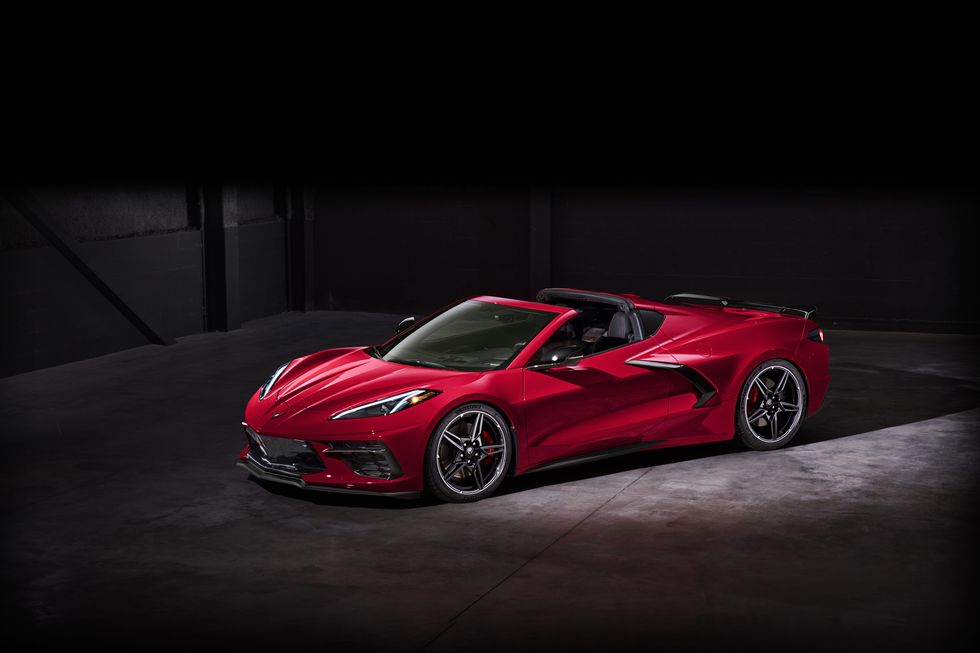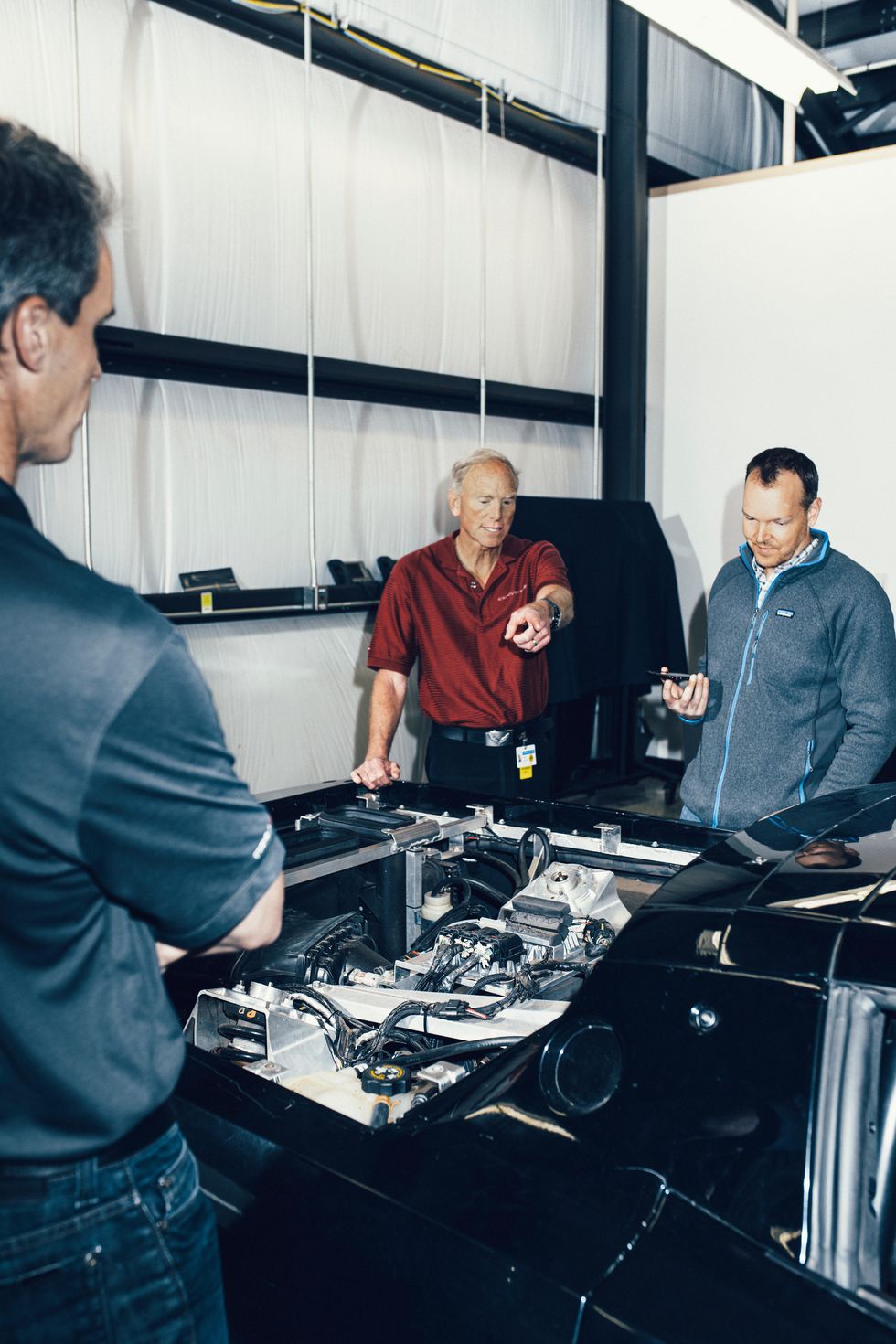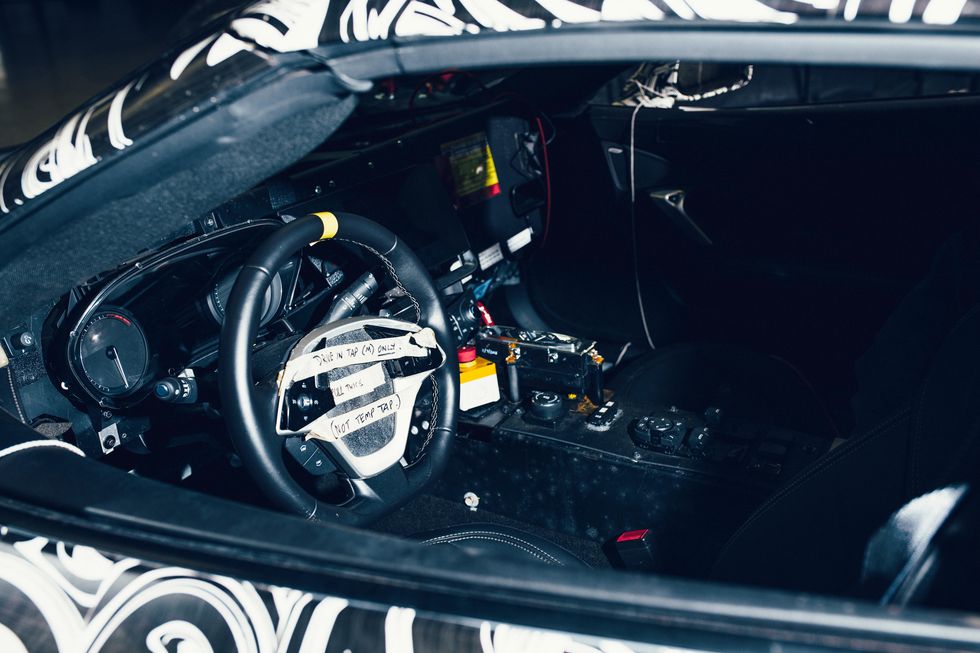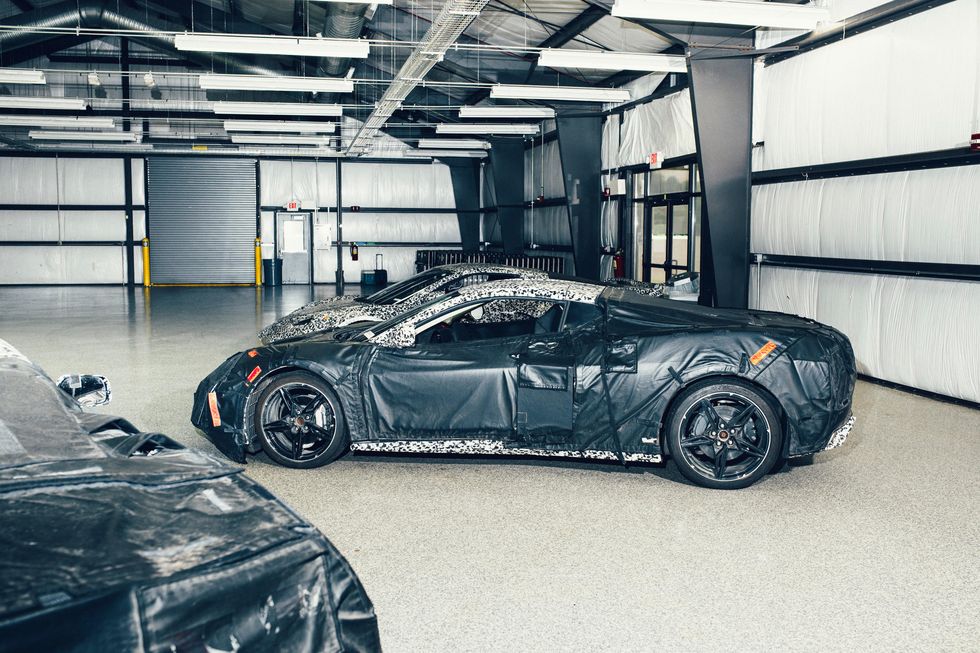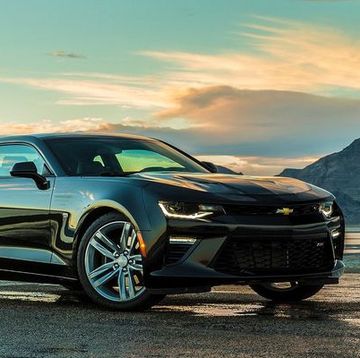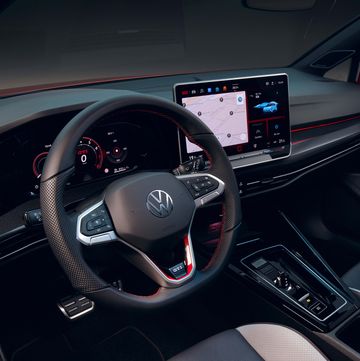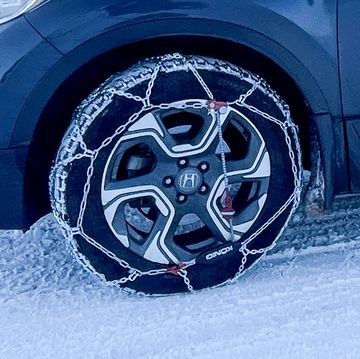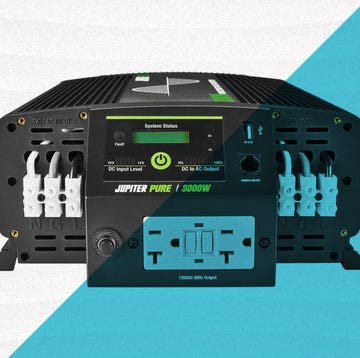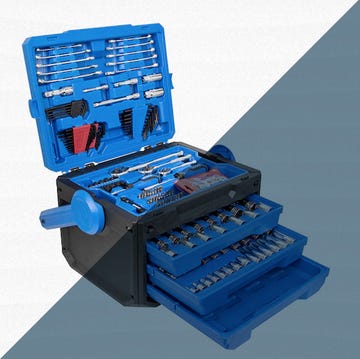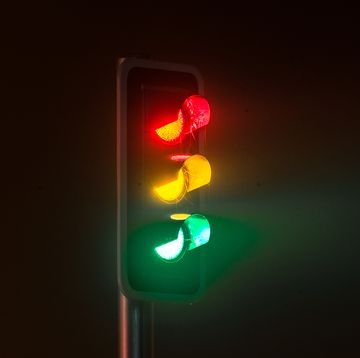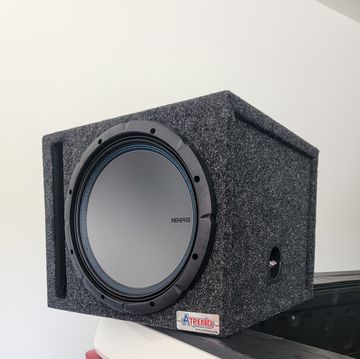Engine: 6.2-liter V8, 495 hp and 470 lb-ft of torque (with performance exhaust) / Transmission: Eight-speed dual-clutch / 0-60: less than 3 seconds, with launch control /Wheelbase: 107.2 inches / Dry Weight: 3,366 pounds / Tires (Z51 package): Michelin Pilot Sport 4S, 245/35/ZR19 front, 305/30/ZR20 rear / Cargo volume: 12.6 cubic feet / Brakes (Z51): 13.3-inch front, 13.8-inch rear, Brembo monobloc calipers / Base Price: Less than $60,000. But probably not much less.
About four and a half years ago, I drove the then-new Corvette Z06 at a track in Nevada. With 650 horsepower, the Z06’s rear tires struggled to cope with a firestorm of torque dispatched by the massive V8 sitting out ahead of the cockpit. For all its superlative capabilities, the Z06 needed more traction, more weight on the rear end. I told Tadge Juechter, Corvette executive chief engineer, “I think to do any better than this, you need to go mid-engine.”
He assumed a look of weary annoyance and replied, “Yeah, that’s what everyone keeps telling me.” Which, you’ll note, was not a denial.
Juechter had a good poker face, because back in Michigan, he and a team of engineers had been working on such a car since 2013. Disguised to look like a mutant Australian pickup truck, it was code-named Blackjack. Under its Holden bodywork, Blackjack was teaching GM how to build a whole new kind of Corvette.
With the mid-engine Corvette finally upon us, I kept thinking about that first rough-hewn test car, which was caught by a spy photographer soon after I drove the Z06. What happened since then? And how did we get from that freaky one-off development car to a production Corvette?
I asked GM whether they still had Blackjack and any other vehicles from the development pipeline—physical snapshots of where they were years ago, cars that show what kind of obstacles they overcame on the way to the polished end product. In the case of a normal mass-market car, GM probably wouldn’t have retained a fossil record of its development. But the mid-engine design is the biggest deal since the Corvette got a V8 in 1955, so GM had the foresight to keep some development cars around. They agreed to convene four of those cars and four key engineers in one room so we could retrace the path that led to the 2020 C8 Corvette.
Blackjack is the oddball. Three of the Corvettes in the garage at GM’s Milford Proving Grounds look reasonably Corvette-like, inasmuch as I can judge their appearance through various degrees of camouflage. But Blackjack wears a pugnacious Holden front end grafted to a C7 cabin that leads to the suggestion of a pickup bed. The bizarre aesthetic points to the first challenge for the team, which was keeping the damn thing a secret.
“Before, we could disguise development work by tweaking a current car,” says Juechter. “You can’t do that with mid-engine proportions, so we decided to make it look like a ute.”
Secrecy was paramount. At GM’s Advanced Vehicle Integration facility in Warren, Michigan, the company built a special room for the C8 with restricted swipe-card access. “If you talk to people at GM, their memory of this car is that it’s the car nobody would let them see,” says Alex MacDonald, Corvette vehicle performance manager. The team used spotters to watch for helicopters, speeding back to a secret garage called The Lair when there was a threat of aerial photography.
At this stage, all that mattered was the basic structure and suspension geometry, the foundation of the car.
“If you look at the wing,” says Juechter, “it’s on upside down. That’s because aerodynamics come into play on suspension development at relatively low speeds, and this front end had a ton of lift. So to get the pitch right, we inverted the wing to add lift to the rear.”
Blackjack’s interior is racecar-crude, its transmission an adapted PDK from a Porsche. But the foundation—structure and suspension—was crucial, determining everything that happened next.
“We knew we only had one chance to get this right,” says Juechter. “Computer models get us in the ballpark, but we have to build hardware so we can learn.”
Among the things they learned is that no supplier on the planet had the high-pressure die capacity to handle the big pieces of the C8’s front and rear structure. For Blackjack, they milled those parts from solid aluminum—7,000 pounds of metal to produce 400 pounds of components. You can do that when you’re building one car. But you also need to consider how you’re going to build thousands of cars.
So, the team worked out plans to make their structural dreams feasible by producing those parts in-house. In the meantime, they had to keep testing. The car next to Blackjack is a mule from 2016. This one has the correct dry-sump V8, the correct GM-developed 8-speed dual-clutch transmission, and the next-gen electrical architecture of the production car. But it’s still one of a dozen cars largely hand-built and still showing elements of improv.
“You still see some C7 structure here, where we could use it,” says Juechter. “Like the doors. One thing that’s really challenging is sealing. You’re going to be testing in the rain, the car needs to be sealed.”
Hence the bits of C7 cabin. But the body structure underneath is real C8.
While these 12 cars were running around Milford, other C8 parts were being tested on current Corvettes—the steering wheel, for instance. Kim Lind, the team’s additive design and manufacturing product application engineer, produced 3D-printed prototype steering wheels—a feat made possible by fusion deposition modeling.
“The wheel was a case where we just had to try it out, live with it and see what we thought,” says Mike Petrucci, Corvette lead development engineer. The final design, the so-called “squircle,” allows a clear view of the new dash display and went through countless iterations before it was finalized.
“It gets down to millimeter by millimeter,” says Juechter. “That’s just the wheel. There are literally a million decisions on the way to making a new car.”
And those decisions get more complex when you move to the integration vehicle phase, represented by the third car in the garage. This is the point where everything has to be production-ready.
And so: They build it.
Over two weeks, throngs of engineers bring in their parts—or 3D-printed facsimiles thereof—and build the first C8 from the ground up, the world’s most complicated IKEA project. There’s no instruction manual. Along the way, they cataloged 400 issues that needed to be addressed to make the car possible for the production line.
"We're learning things like whether there's hand space for the worker on the line to install a particular part." says Juechter. "It's Engineer A didn't talk to Engineer B, that sort of thing."
The integration vehicles are also where the team addresses small details, from stuff you just expect to work, like the fuel gauge, to subjective topics, like shift quality. “We’re tuning on the racetrack,” says Petrucci. “You’re taking a pile of parts and turning them into a Corvette.”
And that pre-production Corvette sits 10 feet away. They just got this car from the Bowling Green factory two months ago, and the interior is still mostly camouflaged. It seems like the car is done, but not quite.
“When you’re used to driving these development vehicles and get into one of these from the production line, it’s different,” says MacDonald. “And you go, OK, why? It’s all the same parts. But it’s balanced differently on the track, the ride and handling has subtly changed. So you figure out what changed and what you need to do to get it back where you want it.”
They’ve got some time—the C8 isn’t slated for production until the end of the year. But given what I’ve seen, I can’t help but wonder: What are they working on next?
And Now...a Few Test Drive Thoughts
What can I tell you from a few laps around the Black Lake with Juechter at the wheel? I can tell you that the C8 rides really well, even though its coil-over suspension is stiffer than the C7’s transverse composite springs. (Your body is neatly aligned with the car’s center of gravity, so you’re not riding the see-saw like in a C7.)
It corners flat, though. "We're doing something here that Porsche couldn't do, unless it inverted its lineup," Juechter says. "It's 911 performance along with the best attributes of the Boxster and Cayman. And some Lexus refinement thrown in, which might surprise people."
I can tell you that even in the wet, it hooks up and goes—there seems to be a whole lot of traction. When Juechter pulls to a stop and stomps the throttle, there's a moment of wheelspin but then the car quickly hooks up. "If this were a C7, we'd still be sitting there spinning," Juechter says.
I can tell you that the push button gearshift works by feel, because the reverse toggle is convex and the one for drive is concave.
I can tell you that the transmission shifts instantly, because the paddles are connected directly to the transmission, with no computer second-guessing. "It's not a manual, but we're going for that manual control," Juechter says.
I can tell you that the C8 can get away with less aggressive tires than the C7 because the chassis is so good—it’ll pull almost 1G on all-seasons.
And I can tell you that it’s super weird to hear this rockin’ American pushrod V8 soundtrack coming from behind your shoulders. It sounds great. It’s just strange.
I’m told that you get used to it.
Ezra Dyer is a Car and Driver senior editor and columnist. He's now based in North Carolina but still remembers how to turn right. He owns a 2009 GEM e4 and once drove 206 mph. Those facts are mutually exclusive.

